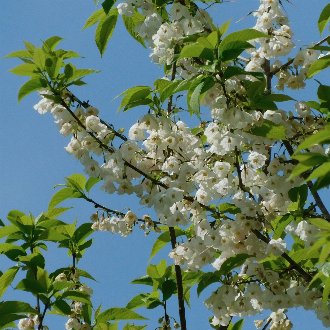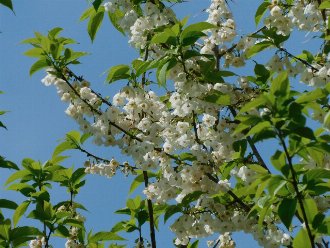Carolina Silverbell (Halesia carolina L.)
Also known as mountain silverbell; also classified as Halesia tetraptera L., Halesia monticola (Rehder) Sarg.
Many authorities including POWO and BONAP have merged the mountain silverbell, Halesia tetraptera, also referred to as Halesia monticola, into this species, and we have accepted this merge, so our links include double entries to authorities that treat them as separate. Some authorities treat that taxon as a subspecies or variety of this one, but we follow POWO's convention that does not recognize any sub-taxa. We noticed a discrepancy in that the USDA listed Ellis as the naming authority for H. tetraptera, whereas POWO listed L., and we have also seen other sources listing it as auct. non. L., suggesting the USDA's citation is in error. However we saw no other implications of this error.
↑Range - Expand
| Legend | Color |
| Expanded or Not Present | |
| Native | |
| Native or Expanded | |
| Expanded | |
| Native or Not Present | |
| Native or Expanded or Not Present |
This map is based on our research. We have checked its accuracy to Level 3 ecoregions. Although this plant occurs somewhere in each of these regions, it may only occur in a small part of some or all of them.
This species is widely cultivated in landscaping, and sometimes escapes into the wild, although it is rare to uncommon in the wild in these areas. We mark the new populations as expanded because of proximity to its native range.
↑Notes
The merge of Halesia tetraptera into this species was conducted primarily due to the observations by Fritsch and Lucas (2000) that the two populations exhibit clinal variation, or extensive gradual intergradation; the populations do not seem to be reproductively isolated, nor do they have a clear or distinct cutoff. Furthermore, the morphology of the previously-proposed species seems to correlate strongly with latitude. These authors hypothesized that the populations now treated as this species may have become isolated during recent glaciation, but as glaciers receded, the groups came back into contact with each other, and the divergence during this isolation was not sufficient to reproductively isolate them. If this theory is true, this taxon thus represents a species that began to speciate, but where the speciation process was interrupted and is now partly reversing.
↑Links & External Resources
• Halesia carolina (Carolina Silverbell) | Illinois Wildflowers (About This Site)
• Halesia carolina (Carolina silverbell)‡ | USDA PLANTS Database (About This Site)
• Halesia tetraptera (mountain silverbell)‡ | USDA PLANTS Database (About This Site)
• Halesia carolina | Go Botany (About This Site)
• Halesia carolina (Carolina Silverbell)‡ | Missouri Botanical Garden Plant Finder (About This Site)
• Silverbell | Virginia Tech Dendrology Factsheets (About This Site)
• Carolina Silverbell | Silvics of North America (About This Site)
• Halesia carolina | Biota of North America Project (BONAP) (About This Site)
• Halesia carolina L. | Plants of the World Online (POWO) (About This Site)
• Halesia carolina‡ | NatureServe Explorer (About This Site)
• Halesia tetraptera‡ | NatureServe Explorer (About This Site)
• Halesia carolina | Flora of North America (About This Site)
• Halesia monticola (Silverbell Iree)‡ | Missouri Botanical Garden Plant Finder (About This Site)
• Little Silverbells‡ | Maryland Biodiversity Project (About This Site)
• Common Silverbells‡ | Maryland Biodiversity Project (About This Site)
• Halesia tetraptera Ellis (Silverbell, Common Silverbell) | Digital Atlas of the Virginia Flora (About This Site)
Different Taxonomic Treatments
‡ These links refer to a larger population than covered by this page.




